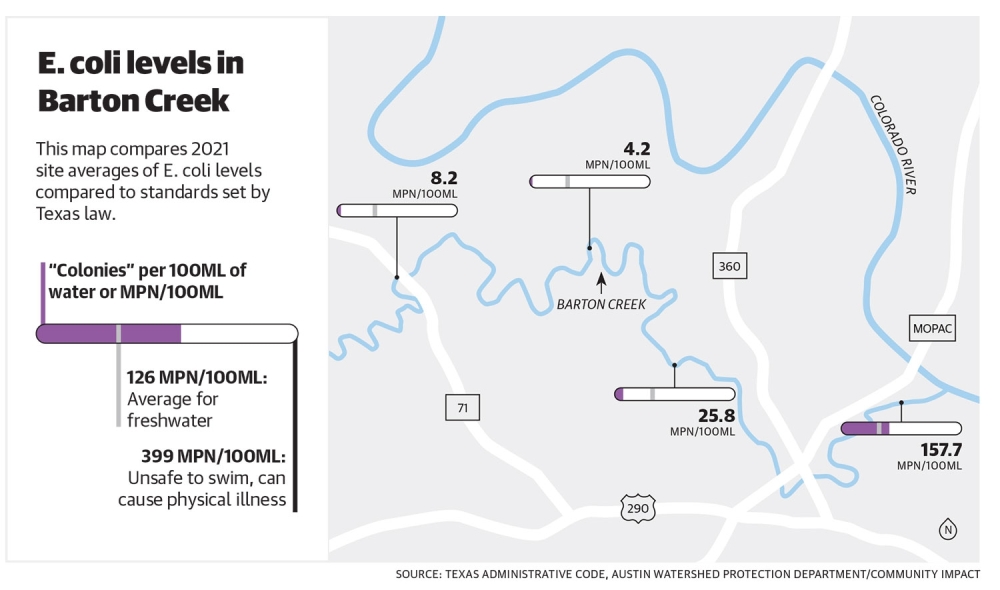Council member Paige Ellis, who authored the resolution, hopes the replacement of a new, larger line outside the environmentally-sensitive area will make way for more development—including the revitalization of Barton Creek Square.
“This is really a generational project for me, and a way for these 1970s, 1980s builds to be able to come into the modern times and be ready for the future,” Ellis said. “There’s no excuse to leave aging infrastructure in place and pretend that there’s not a problem.”Two-minute impact
The resolution approved May 30 kicks off planning for the removal of the Barton Creek Wastewater Interceptor, which runs more than 2 miles through the Barton Hills and Zilker Park area, buried in and near Barton Creek.
Much of the line was built decades ago, predating the 1992 Save Our Springs Ordinance establishing new environmental protections around Barton Springs. City code has since generally prohibited new development and utility lines in critical water quality zones.
Given its pathway along Barton Creek, Ellis said she’s “absolutely concerned” the old pipes may already be contaminating the waterway with Southwest Austin’s sewage, pointing to reports of higher E. coli levels and lower water chemistry ratings in the area.
Additionally, the capacity of the pipe remains outdated, stunting commercial development for the Rollingwood, West Lake Hills and Barton Hills areas.
Ellis said multiple projects in her district have stalled out over the years due to the wastewater system hitting its limits.

What they're saying
City leaders from both Rollingwood and West Lake Hills expressed support for the project. While septic use is prevalent in both cities, the Barton Creek line’s limited capacity was noted as a key factor impeding their long-range city planning.
Both cities are in the process of reviewing new commercial opportunities along the Bee Caves Road corridor, with Rollingwood specifically eyeing expanded retail and restaurant offerings.
West Lake Hills City Administrator Trey Fletcher said the city relies on Austin’s wastewater systems, so it’d be a challenge to shift to a different system.
“I think redevelopment—whether it’s opportunities in Austin or Rollingwood or West Lake Hills or unincorporated areas that may benefit from this—it’s kind of the tide that raises all boats,” Fletcher said.
Additionally, real estate developers for Barton Creek Square said the replacement would finally set redevelopment options for the mall in motion.
Simon Property representative Stephen Shea said the company has been trying to redevelop the property, originally built in the 1980s, for about a decade, even passing over options to use the parking lot to build affordable housing due to the capacity limits.
“We envision a vibrant redevelopment that would provide much-needed housing and improved environmental standards,” Shea said at the meeting.
A point of contention
As evidence of a possible pipe leak, the resolution highlights a 2023 city report which rated the Barton Creek area between Hwy. 71 and Zilker Park “fair” for water chemistry and showed higher than average E. coli levels. According to Austin Water, however, the wastewater mains near Barton Springs are inspected on five- and 10-year cycles and haven’t shown signs of disrepair. Utility spokesperson Amy Petri also said inspections in 2009, 2010, 2021, 2022, 2023 and 2024 revealed “no noted structural defects or evidence of pipe leaking.”
Austin stream biologist Andrew Clamann said higher E. coli levels are common in urban areas and do not always indicate wastewater contamination.

The other side
While some advocates support the resolution, others have voiced concerns.
“We want to know that any plans to redevelop Barton Creek Square or any of the surrounding areas won’t cause new problems while trying to solve old problems,” said Brian Zabcik, Save Barton Creek Association advocacy director.
Bill Bunch, who heads Austin’s Save Our Springs Alliance, said increased impervious cover like rooftops and parking lots could deplete and pollute the St. Edwards Aquifer, which feeds Barton Creek.
Ellis said new development would follow stricter environmental regulations than many structures built before the 1992 ordinance.
SOS Ordinance
New development in areas near the Barton Creek watershed must follow standards set by the 1992 Save Our Springs Ordinance. The ordinance:
- Sets impervious cover limits
- Establishes pollution prevention standard
- Requires enhanced water quality controls, which includes “Redevelopment exemption” that exempts the redevelopment of a site located in the Barton Springs zone already built prior to 1992
What's next
The resolution directs city staff to return to council with plans for its relocation by November. Before the city report is completed, Austin Water staff will analyze the Southwest Austin-area wastewater system and capacity needs.
Petri said the utility team still has to identify which redevelopments or other stakeholders will be involved in this year’s process.
“We need to make sure that we have modern standards. ... We know better now, and we have a chance to do better for the next 30, 40 years with our infrastructure,” Ellis said.






